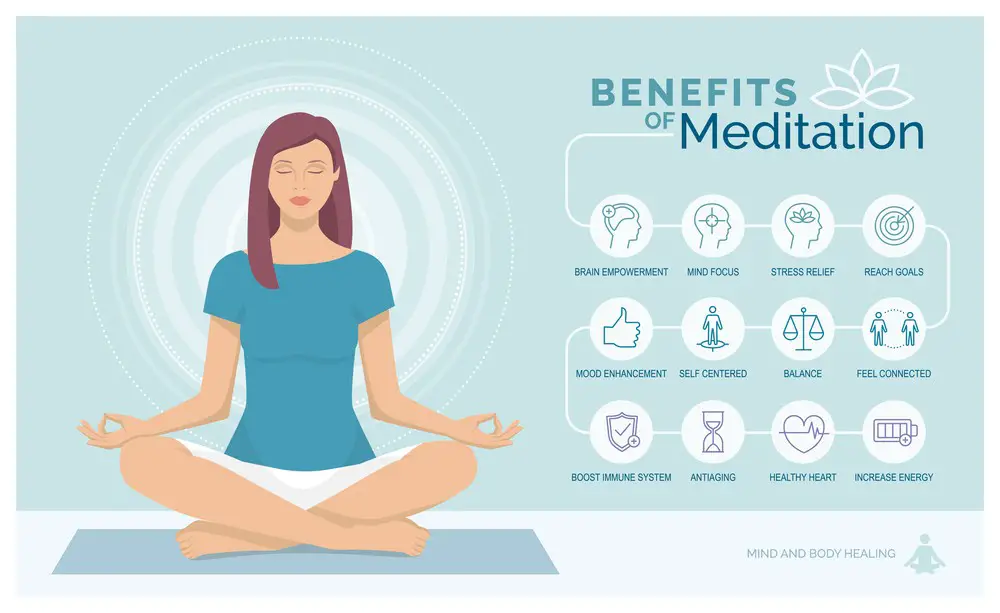As a BetterHelp affiliate, we receive compensation from BetterHelp if you purchase products or services through the links provided
Transcendental meditation mantras have gained popularity thanks to their simple yet powerful technique that promotes relaxation and inner peace. Originating in ancient Vedic traditions, these mantras are unique sounds or vibrations repeated silently in the mind during meditation sessions. As practitioners focus on their chosen mantra, they transcend ordinary thoughts and experience a deep, restful awareness.
The selection of a mantra may vary among practitioners, depending on personal preferences and instructed guidance. Some examples of popular mantras and their meanings include “So Hum,” which translates to “I am that,” and “Om Namah Shivaya,” meaning “I bow to the inner self.” Transcendental meditation typically involves sitting comfortably with eyes closed for about 20 minutes twice daily. The benefits of transcendental meditation range from improved mental clarity and reduced stress to enhanced creativity and overall well-being.
Key Takeaways
- Transcendental meditation mantras come from ancient Vedic traditions and promote relaxation and inner peace.
- Choosing a mantra and practicing meditation regularly can bring various benefits, including mental clarity and reduced stress.
- Transcendental meditation has gained popularity due to its simplicity and evidence-backed effectiveness.

Transcendental Meditation Mantras
Transcendental Meditation (TM) is a technique that helps people access a state of deep relaxation and inner peace by using mantras. These mantras are specific sounds or vibrations that calm the mind and body when repeated silently.
In TM, each meditator is given a unique and personal mantra. This mantra is typically a one or two-syllable sound used throughout their practice. It is important to note that TM mantras are not words with any specific meaning. They are tools for the mind to focus on, helping the individual achieve inner quietness.
Practitioners of TM sit comfortably with their eyes closed, silently repeating their mantra for about 20 minutes twice a day. This repetition helps the meditator to gently settle down into a state of deep relaxation and transcendental consciousness. The regular practice of TM is known to have numerous benefits, such as reduced stress and anxiety, enhanced mental clarity, and improved overall well-being.
While the specific transcendental meditation mantras are kept secret and only revealed to students by certified TM teachers, some traditional mantras are available for those interested in trying TM-like practices. Some examples of mantras that have been used in meditation practices include “Aum,” “Shring,” and “Ram.” However, consulting with a qualified TM teacher is important to receive a personalized mantra for an authentic and effective experience.
In conclusion, transcendental meditation mantras play a crucial role in helping individuals achieve a state of profound relaxation and aliveness. With regular practice, TM has the potential to improve mental and physical health, leading to a more balanced and fulfilling life.
Origins and Principles
Transcendental Meditation (TM) was a meditation technique Maharishi Mahesh Yogi introduced in the 1950s. Maharishi Mahesh Yogi was an Indian spiritual teacher who developed and promoted the practice worldwide during his lifetime. The Transcendental Meditation technique provides a foundation for personal development and improved mental well-being.
TM is based on the principles of mantra-based meditation. In this context, a mantra is a sound or vibration silently repeated to create a calming effect on the mind. The technique involves sitting comfortably with eyes closed and effortlessly focusing on a specific mantra. This process allows the mind to settle inward beyond thought, reaching a state of deep relaxation and inner peace.
The selection of mantras in Transcendental Meditation is based on the individual’s characteristics, ensuring that each practitioner has a specific and tailored experience. Maharishi Mahesh Yogi emphasized the importance of knowledge in this process, stating that by understanding the correct technique, one could achieve full potential through meditation.
Transcendental Meditation is unique in its simplicity and effectiveness, enabling individuals of varying backgrounds and lifestyles to easily incorporate the practice into their daily routines. It is designed to provide a natural and effortless means of achieving deep rest, mental clarity, and inner expansion without requiring extensive training or religious affiliation.
This technique has garnered interest from scientists and researchers, leading to numerous studies investigating its effects on physical and mental health. With promising evidence of benefits such as reduced stress, improved creativity, and increased cognitive capacity, Transcendental Meditation holds a notable position among popular meditation practices today.

Choosing a Mantra
When practicing transcendental meditation, selecting the right mantra is an essential part of the process. A mantra is a sound, word, or phrase repeated silently to help focus the mind and facilitate meditation. Mantras are typically meaningless sounds, allowing the meditator to concentrate without becoming attached to any specific meaning.
Om or Aum is a popular and universally recognized mantra. It is considered the primordial sound of creation and is a powerful foundation for many meditation practices. However, selecting a mantra can be more personal, and individuals may choose a sound that resonates with them deeper.
In transcendental meditation, selecting a mantra that suits the individual’s needs and preferences is essential. Factors to consider when choosing a mantra include:
- Association: It is important to avoid choosing a mantra that is associated with any specific belief system or meaning. Instead, focus on a sound that carries no personal or emotional significance.
- Simplicity: A simple sound or word is recommended for beginners in meditation. Complex phrases or words can make focusing more challenging and may provide distractions during practice.
- Vibration: A key aspect of transcendental meditation mantras is the vibration they produce during repetition. Pay attention to how the sound feels as it resonates through the body, and choose one that feels comfortable and natural.
- Personal connection: While avoiding sounds with associations is essential, choosing a personal mantra can be helpful. A mantra should resonate deeply with the individual, creating a sense of unity and calm during practice.
One can consult a meditation teacher or utilize resources such as books, websites, or apps to suggest a mantra. Experimenting with different sounds and paying attention to the body’s response can reveal which mantra will be most effective for an individual’s practice. Ultimately, the choice of mantra should promote relaxation and inner peace during transcendental meditation.
Popular Mantras and Their Meanings
Transcendental meditation mantras have roots in various traditions, including Hinduism, Jainism, and yoga practices. These mantras, typically in Sanskrit, serve as sacred formulas to guide and focus the meditator’s energy and awareness. Here are some popular mantras and their meanings.
Om Mani Padme Hum: This Buddhist mantra means “Praise to the jewel in the lotus.” It represents compassion and invokes the blessings of the bodhisattva of compassion, Avalokiteshvara. With its six syllables, it is said to purify and balance the six realms of existence.
Om Shanti: In Hinduism and yoga, “Om Shanti” means “peace.” The syllable “Om” represents universal consciousness, while “Shanti” means peace, invoking inner equanimity and harmony with the world.
Om Namah Shivaya: This popular Hindu mantra honors Lord Shiva, the supreme deity symbolizing creation, destruction, and transformation. Its meaning can be translated as “I bow to Shiva” or “I honor the inner self,” promoting self-realization and inner growth.
Sat Nam: Commonly used in Kundalini yoga, “Sat Nam” means “true identity” or “truth is my name.” It emphasizes connecting with one’s inner truth and balancing life’s physical and spiritual aspects.
So Hum: Meaning “I am that” in Sanskrit, this mantra is used in meditation to connect with the divine within oneself. As the breath flows naturally, silently repeating “So” on inhalation and “Hum” on exhalation can bring deep awareness to the present moment.
Ham-Sah: Known as the “breath mantra,” this mantra represents the natural sound of inhalation (Ham) and exhalation (Sah). It promotes a deeper connection with the breath and encourages mindfulness.
Om Gam Ganapataye Namah: Dedicated to Lord Ganesha, the Hindu deity of wisdom and obstacle removal, this mantra translates to “I bow to the elephant-faced deity (Ganesha) who is capable of removing all obstacles.” Practitioners use it to invoke Ganesha’s assistance in navigating through challenges.
I am that I am: With roots in Western spiritual traditions, this mantra represents the profound insight that one’s true identity transcends physical form and personality. It can be used to connect with the divine essence within and realize the unity of all existence.
Whether derived from ancient traditions or modern interpretations, these mantras offer rich spiritual guidance and self-awareness. Practicing them with sincerity and dedication can bring profound shifts and cultivate a deeper inner peace.

The Practice of Transcendental Meditation
Transcendental Meditation (TM) is a meditation practice where individuals focus on a mantra to achieve a state of calm and relaxation. A certified teacher guides the learner in learning the TM technique. It is crucial to receive instruction from a trained professional to ensure proper guidance and understanding of the method.
When practicing TM, individuals sit with their eyes closed and upright. This posture allows for better focus and relaxation, leading to a more effective meditation session. Sitting upright also helps maintain alertness, which is essential to avoid dozing off during practice.
The TM technique’s core lies in repeating a specific mantra. The mantra is a sound or phrase with no meaning, allowing the practitioner to focus solely on the sound without distracting thoughts. Certified teachers select an individualized mantra for their students based on specific factors, ensuring a unique and tailored experience for each person.
During a typical TM session, participants repeat their mantra silently while maintaining a passive attitude. It’s crucial to resist the urge to control or analyze the mantra, as doing so can hinder the relaxation process. By concentrating on the mantra with a calm and undisturbed mind, individuals can achieve a state of deep relaxation and inner peace.
Consistent practice of Transcendental Meditation can lead to numerous benefits, including reduced stress, increased focus, and enhanced overall well-being. With proper guidance from a certified teacher and dedication to the technique, individuals can greatly improve their meditation experience and enjoy the positive effects of Transcendental Meditation in their daily lives.
Benefits of Transcendental Meditation
Transcendental Meditation (TM) is a technique that promotes deep relaxation and mental focus. Practitioners experience various benefits, including reduced stress, anxiety relief, and inner peace. This section will examine some of the key benefits associated with TM.
One significant benefit of TM is stress reduction. As people practice TM regularly, they report experiencing decreased stress levels. This stress reduction can positively affect mental and physical health. For example, lower stress levels may result in lower blood pressure, which benefits cardiovascular health.
Another benefit of TM is its ability to help manage anxiety. TM practitioners claim that regular practice helps create a sense of calm and peace, which can help reduce anxiety. This, in turn, can positively impact mental health by promoting a more balanced emotional state.
TM also promotes inner peace and self-awareness. As individuals practice TM, they might develop a heightened sense of self and a deeper connection to their inner selves. This can foster contentment and harmony, further contributing to overall mental well-being.
In addition to mental health benefits, TM has been linked to improvements in physical health. For instance, some studies have shown a correlation between TM and lowered blood pressure. This could help those with high blood pressure to manage their condition better. Moreover, the relaxation TM brings can contribute to a healthier nervous system, as it may help counteract the negative effects of stress and anxiety on the body.
In summary, Transcendental Meditation offers multiple benefits to those who practice it regularly. These benefits include reduced stress and anxiety, inner peace, mental clarity, and improved physical health by lowering blood pressure and fostering a healthier nervous system.
Scientific Evidence of Benefits
Transcendental meditation (TM) has gained recognition in recent years due to its numerous benefits backed by scientific research. One significant aspect of TM is the usage of mantras, which are believed to promote relaxation and reduce stress.
Numerous studies have pointed to the mental health benefits of TM. For instance, research has shown that regular practice of TM can reduce anxiety and depression. This is because TM helps regulate the nervous system, promoting a more balanced emotional state.
In addition to emotional benefits, TM has been associated with improved cognitive abilities. Practitioners often report enhanced focus, mental clarity, and memory. These benefits have been corroborated by scientific studies showing increased activity in the brain’s prefrontal cortex, which is responsible for executive functions like decision-making and problem-solving.
Moreover, TM has been found to impact blood pressure positively. A meta-analysis of randomized controlled trials demonstrated that practicing TM led to a significant reduction in both systolic and diastolic blood pressure. This is essential as high blood pressure is a major risk factor for cardiovascular diseases.
Lastly, TM has been linked to improved brain function in general. Studies using electroencephalography (EEG) have revealed that TM practitioners exhibit increased alpha-wave activity, indicating a state of deep relaxation. This relaxed state allows the brain to function more efficiently, leading to an overall improvement in mental well-being.
In conclusion, transcendental meditation and using mantras have been scientifically proven to offer a range of benefits, including better mental health, cognitive enhancement, and reduced blood pressure. This evidence supports the idea that TM can be a valuable tool for promoting overall well-being and enhancing life quality.
Meditation for Various Purposes
Transcendental meditation mantras serve different purposes, depending on the practitioner’s intent. Individuals can harness the power of vibrations, energy, and concentration to achieve desired outcomes by focusing on specific mantras.
One such purpose is to boost energy levels. Individuals can increase their vibration and energy levels by chanting particular mantras. Consistent practice helps keep energy levels high and promotes a more active lifestyle.
Meditation targeted towards compassion is another essential aspect. Individuals can cultivate a higher sense of empathy and understanding by reciting specific bodhisattva mantras, positively impacting their relationships and interactions.
Improving concentration and focus is yet another purpose of meditation. Practicing specific mantras can enhance their mental clarity and attentiveness, making them more productive and efficient daily. This type of meditation is particularly beneficial for professionals or students requiring high levels of focus.
Chanting mantras in transcendental meditation can also help in nurturing relationships. These mantras foster positive vibrations within oneself, which leads to better communication and emotional connections with others. Individuals create a conducive environment for maintaining healthy relationships by incorporating mantras for relationships.
Finally, meditation focused on connecting with one’s higher self can provide peace and introspection. Individuals can connect deeply to their inner being by utilizing mantras that resonate with the higher self. This process strengthens self-awareness and promotes a more balanced state of mind.
In summary, by utilizing transcendental meditation mantras, individuals can work on various aspects of their lives, from enhancing energy levels, developing compassion, improving focus, nurturing relationships, and connecting with their higher selves. The power of chanting and vibrations allows for versatile meditation, catering to many purposes and ensuring holistic personal growth.
Celebrities and Transcendental Meditation
Transcendental Meditation (TM) has gained popularity not only among everyday people but also among celebrities. The practice reduces stress, improves mental clarity, and promotes overall well-being. Several well-known figures have openly discussed their experiences with TM and advocated for the practice.
Hugh Jackman, the famous actor, credits TM in his life and career. He has been practicing the technique for over a decade and notes its positive impact on his creativity, focus, and energy levels. Jackman has expressed that TM allowed him to find peace amidst his hectic Hollywood life.
Another devoted TM practitioner is the renowned comedian Jerry Seinfeld. Seinfeld began practicing TM in the 1970s as a young comedian and has continued ever since. In interviews, he mentioned that TM enables him to maintain balance and calmness and is a source of rejuvenation in his life.
David Lynch, the influential filmmaker, is a passionate advocate for TM. He founded the David Lynch Foundation to promote the practice to individuals, schools, veterans, and other groups. The foundation has supported numerous programs to bring the benefits of TM to those in need, believing that these techniques can transform lives.
These celebrities, along with many others, have endorsed the practice of Transcendental Meditation. By sharing their experiences, they help to raise awareness of TM and its potential benefits in personal growth, mental health, and overall well-being, reinforcing the value of the technique in today’s fast-paced world.

TM for Women
Transcendental Meditation (TM) is an effective technique for both men and women, but it has some unique benefits for women. As stress levels continue to rise, learning and practicing TM can be a valuable tool to combat daily stress and maintain overall well-being, especially for women with multiple roles and responsibilities.
TM involves the use of a specific mantra tailored to each individual. Mantras are sound vibrations that help the mind settle into deep relaxation. Women who practice TM report various mental and physical benefits, including reduced stress, anxiety, and fatigue.
One of the benefits of TM for women is its impact on hormonal balance. TM helps regulate the hormonal system, which can be particularly important for women experiencing menstrual problems, menopause symptoms, or balance-related emotional issues. Regular TM practice can help smooth hormonal fluctuations, reduce mood swings, and improve overall emotional stability.
In a work-life balance context, TM can be particularly beneficial for women juggling family and career responsibilities. TM allows women to manage their time and energy better, increasing productivity and reducing burnout. This meditation technique is simple to learn and takes only 20 minutes twice daily, making it easily adaptable to busy schedules.
Moreover, TM is beneficial for women during pregnancy and postpartum periods. Regular meditation can help improve sleep quality, reduce stress, and support emotional well-being during pregnancy, directly impacting the mother’s and baby’s health. Postpartum, TM can also aid in recovery and help women manage early motherhood’s emotional and mental demands.
Overall, the practice of TM can provide valuable support for women in various stages of life. The benefits of reduced stress, improved emotional and hormonal balance, and greater work-life balance are essential to maintaining a healthy lifestyle and navigating women’s unique challenges.
Comparison with Other Forms of Meditation
Transcendental meditation mantras are a key aspect of the transcendental meditation (TM) technique. While there are various types of meditation, it is important to compare TM with other popular forms, such as mindfulness meditation, kundalini yoga, and mantra-based meditation, to provide a clearer understanding of their differences.
Mindfulness meditation is rooted in focusing one’s attention on the present moment and observing thoughts and emotions without judgment. It helps in developing awareness, concentration, and a sense of balance. On the other hand, transcendental meditation utilizes a specific mantra, repeated silently, to effortlessly bring the awareness inward, allowing the practitioner to experience a deeply restful state of consciousness.
Kundalini yoga combines physical postures, breath control, meditation, and chanting mantras to awaken and balance the kundalini energy. This energy is believed to reside at the base of the spine and, when activated, can lead to spiritual development and overall well-being. Unlike TM, kundalini yoga emphasizes the integration of body, mind, and spirit through physical practice and attunement to subtle energies.
Mantra meditation is a form of meditation that employs the repetition of a specific mantra, either silently or aloud, to cultivate focus and concentration. Mantras can also be used in mindfulness meditation and kundalini yoga. However, it is essential to recognize that TM is a particular mantra-based meditation technique. Maharishi Mahesh Yogi developed it and followed a structured approach for the selection and personalized use of mantras.
Overall, these forms of meditation aim to bring mental clarity, cultivate inner peace, and enhance personal well-being. Nevertheless, their methods, techniques, and principles may differ significantly. Transcendental meditation, focusing on mantra repetition, sets itself apart from mindfulness meditation’s emphasis on present-moment awareness and kundalini yoga’s integration of physical practice and energy work.
Conclusion
Transcendental Meditation (TM) mantras are essential to the TM practice. They serve as a mental vehicle that helps individuals dive into their innermost selves, leading to deep relaxation and inner peace.
The use of mantras in TM differentiates it from other meditation techniques. It does not involve mindfulness or concentration but is based on effortless repetition of a specific sound. This passive approach makes it easier for practitioners to develop a daily meditation routine and experience the benefits over time.
Although varied, these benefits share a common foundation in improving overall well-being. Regular TM practice has been linked to stress reduction, increased mental clarity, and improved cognitive function. Furthermore, these powerful tools have been used to help individuals suffering from anxiety, depression, and other stress-related disorders.
In conclusion, TM mantras remain essential to this widely practiced meditation technique. Their effectiveness in helping individuals unlock their full potential for clarity and inner peace has made TM a valuable resource for people worldwide seeking to improve their lives mentally and emotionally.
Frequently Asked Questions
How many mantras are in TM?
There are several mantras in Transcendental Meditation (TM), although the exact number is not publicly disclosed. Each practitioner is given a unique mantra suited to their individual needs.
What is a typical mantra for Transcendental Meditation?
A typical mantra for TM is a simple word or phrase, often originating from ancient Sanskrit texts. Examples include ‘Om’ and ‘Shirim.’ Mantras are chosen based on various factors, such as age and life experience. It’s important to note that one should receive their mantra from a qualified TM teacher for the TM technique to be effective.
Can you do Transcendental Meditation without a mantra?
Transcendental Meditation relies on a mantra to help the practitioner transition into deep relaxation effortlessly. Without a mantra, the TM technique may not be as effective since the mantra is a key aspect of its practice. It is not advisable to attempt TM without a mantra.
How do I find my mantra?
You should schedule an appointment with a certified TM teacher to find your mantra. They will provide personalized instruction, including selecting a mantra based on your needs. Choosing a mantra on your own or online is not recommended, as it may not suit your unique practice.
TM mantras pronunciation tips?
When practicing TM, it is important to pronounce the mantra correctly, as it can significantly impact the effectiveness of the practice. Here are a few tips for proper pronunciation:
- Focus on the sounds, rather than the meaning of the mantra.
- Allow the mantra to become increasingly gentle and subtle as you repeat it.
- If you struggle with pronunciation, seek guidance from your TM teacher.
What are some TM mantras for beginners?
It is highly recommended for beginners to receive their mantras from a qualified TM teacher. A personalized mantra will be selected for you, ensuring it suits your unique needs. Starting with the guidance of a TM teacher will provide a foundation for a successful TM practice and the support needed for ongoing personal development.
- 7 Ideas to Help You Relax and Unwind on a Family Vacation - April 27, 2025
- How Having Cybersecurity Protection Helps You Relax - April 25, 2025
- 8 Reasons Why Spending Time Outside Calms You Down - April 25, 2025
This site contains affiliate links to products. We will receive a commission for purchases made through these links.



